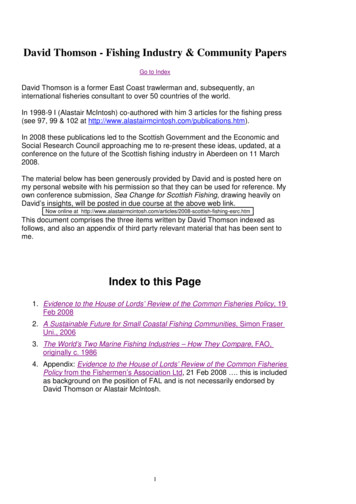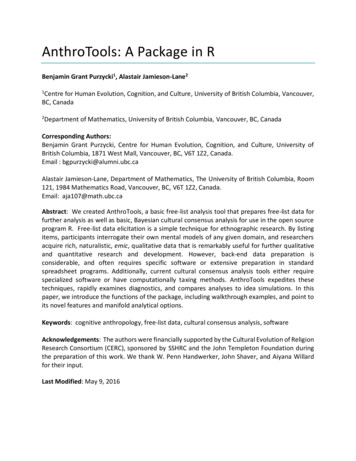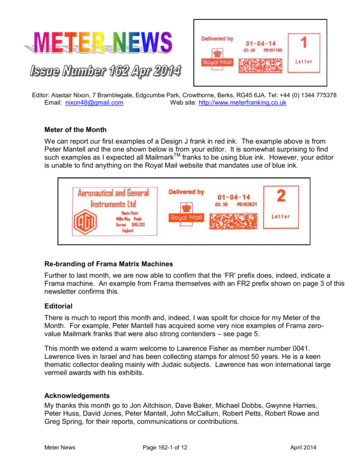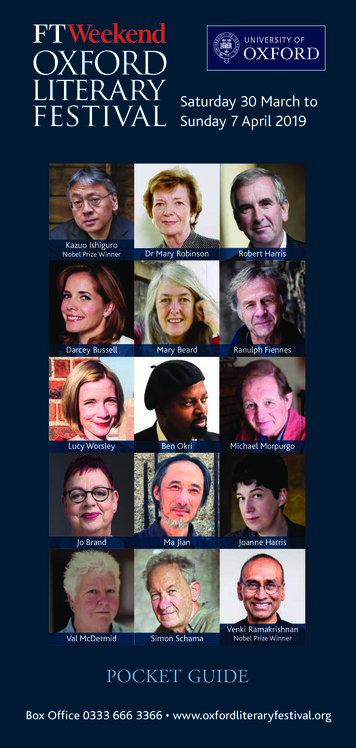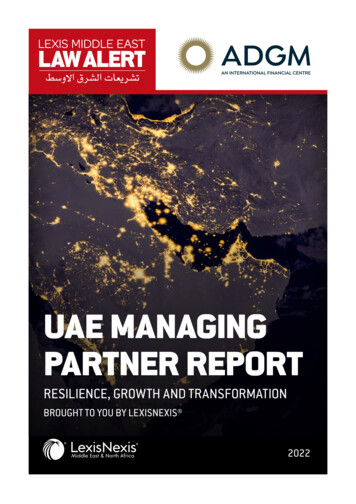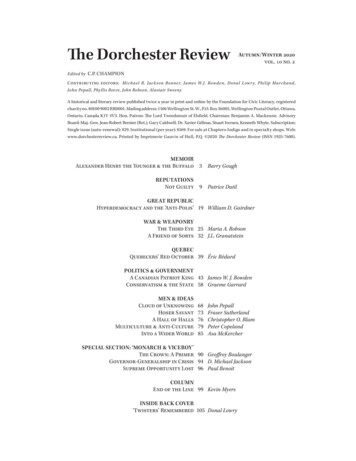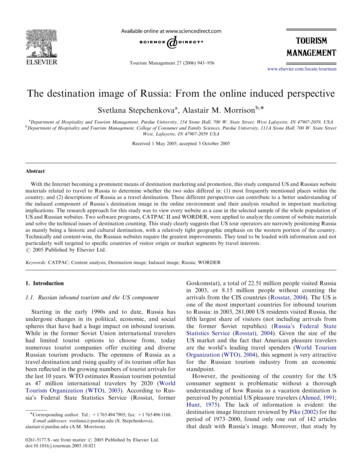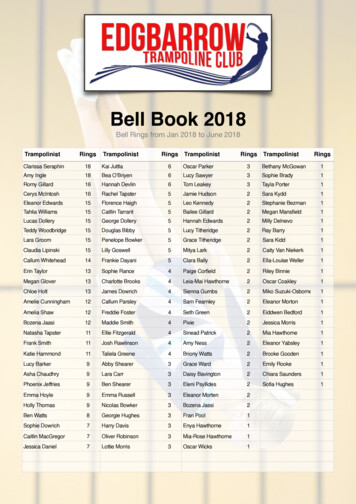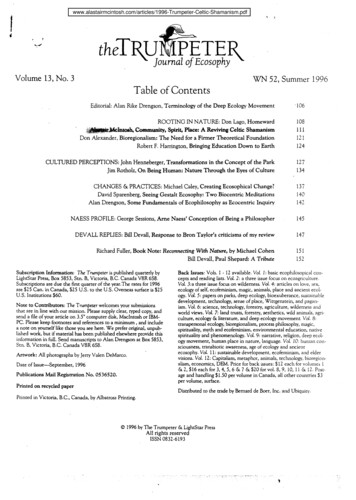
Transcription
eltic-Shamanism.pdftheTRUlPETERJournal of EcosophyVolume 13, No. 3WN52, Summer 1996Table of ContentsEditorial: Alan Rike Drengson, Terminology of the Deep Ecology Movement106ROOTING IN NATURE: Don Lago, Homeward108 b»ttir.McIntosh, Community, Spirit, Place: A Reviving Celtic Shamanism111Don Alexander, Bioregionalism: The Need for a Firmer Theoretical Foundation121Robert F. Harrington, Bringing Education Down to Earth124CULTURED PERCEPTIONS: John Henneberger, Transformations in the Concept of the Park127Jim Rotholz, On Being Human: Nature Through the Eyes of Culture134CHANGES & PRACTICES: Michael Caley, Creating Ecosophical Change?13 7David Sparenberg, Seeing Gestalt Ecosophy: Two Biocentric MeditationsAlan Drengson, Some Fundamentals of Ecophilosophy as Ecocentric Inquiry140142NAESS PROFILE: George Sessions, Arne Naess' Conception of Being a Philosopher145DEVALL REPLIES: Bill Devall, Response to Bron Taylor's criticisms of my review147Richard Fuller, Book Note: Reconnecting With Nature, by Michael Cohen151Bill Devall, Paul Shepard: A Tribute152Subscription Information: The Trumpeter is published quarterly byLightStar Press, Box5853, Stn. B, Victoria, B.C. Canada V8R 6S8.Subscriptions are due thefirstquarterofthe year.The ratesare 25 Can. in Canada, 25 U.S.to the U.S. Overseas surface is 25U.S. Institutions 60.Back Issues: Vols. 1-12 available. Vol.I:basic ecophilosopical con cepts and reading lists. Vol.2: a three issue focusonecoagricukure.1996Vol. for3:athree issue focus on wilderness. Vol. 4: articlesonlove,sex,ecology of self, ecofeminism, magic, animals, place and ancient ecol ogy. Vol. 5: papers on parks, deep ecology, bioexuberance, sustainabledevelopment, technology, senseofplace, Wittgenstein,andpagan Note to Contributors: The Trumpeter welcomes your submissionsism. Vol. 6: science, technology, forestry, agriculture, wilderness andthat are in line with our mission. Please supply clear, typed copy,and world views. Vol. 7: land trusts, forestry, aesthetics, wild animals, agri send a file of your article on 3.5" computer disk, Macintosh or IBMculture, ecology & literature, and deep ecology movement Vol.8:PC. Please keep footnotes and referencesto aminimum,andincludetranspersonal ecology, bioregionalism, process philosophy, magic,a note on yourself like those you see here. We prefer original, unpub spirituality, myth and ecofeminism, environmental education, nativelished work, but if material has been published elsewhere provide thisspirituality and phenomenology. Vol. 9: nanative, religion, deep ecol information in full. Send manuscripts to Alan DrengsonatBox5853,ogy movement, human place in nature, language. Vol. 10: human con Stn. B, Victoria, B.C. Canada V8R 6S8.sciousness, transbiotic awareness, ageofecology and ancientecosophy. Vol.11: sustainable development, ecofeminism,andelderArtwork: All photographs by Jerry Valen DeMarco.visions. Vol. 12: Capitalism, metaphor, animals, technology, bioregion alism, economics, DEM. Price for back issues: 12 eachforvolumes1Date of Issue—September, 1996& 2, 16 each for3, 4, 5, 6 & 7 & 20forvol.8, 9, 10,11&12. PPublications Mail Registration No. 0536520.age and handling 1.50 per volumeinCanada, all other countries 3per volume, surface.Printed on recycled paperDistributed to the trade by BernarddeBoer, Inc.andUbiquity.Printed in Victoria, B.C., Canada, by Albatross Printing. 1996 by The Trumpeter & LightStar PressAll rights reservedISSN 0832-6193
Community, Spirit, Place: A Reviving Celtic ShamanismAlastair McIntoshAFaerie Story about the Conference of the Interna tional Transpersonal Association, Killamey, Ire land, May 1994. [This article is forthcoming in1997 in the Edinburgh Review.]It is said that the close study of stone will reveal tracesof firessuffered thousands of years ago. I am beginning to believethat we know everything, that all history, including thehistoryof each family, is part ofus, such that, when we hearany secretrevealed our lives are made suddenly clearer tous. Perhapswe are like stones; our own history and the historyof the worldis embedded inus, we hold a sorrow deep within and cannotweep until that history is sung. (Susan Griffin, A Chorus ofStones: The Private Life of War. )StoneI grew up ten miles from the Callanish Stones on Lewisin the Outer Hebrides, off the north-west of Scotland. Tomost of us then, the Stones were nothing special. Theywere a place to take visitors; a place to get cold while stand ing around as they took pictures. Others may have feltsome magic, but I never did, nor any local person known tome as a boy. In those days most of the upper part of the vil lage was comprised of thatched stone "black houses." I re member then, in the early sixties, thinking that this was themost important part to set in my mind because it wouldsoon be gone. It has now been gone, since about 1970,which in my perception was the time when the modemworld became most fully triumphant in these western edgesof the Old World; the time when, for instance, we lost ourcoastline fisheries to technology, greed and global econom ics . the period when those siblings of earlier generationswho had gone forth from our soil to the great New Worldlanded on the moon . but that is another story. This one ismainly about Stones.In the nineteenth century, Lady Matheson, proprietorof Lewis, cleaned up the site at Callanish because thestones were being used as a public convenience by the vil lagers. Apparently this caused quite a fuss, removing as itdid the only amenity value the Stones had. There was noinkling of any religious significance, though I do know amodern day wicca woman resident on Lewis who says that,until her recent death there was an old woman living by theStones who did know some of their secrets; feeling too theirconnection with the "Sleeping Beauty" mountain to theSouth, under the Ben Mhor by the awesome Loch Seaforth.I was back at Callanish in early May this year with agroup of students on their Human Ecology field trip. JohnMacGregor was with us; a wise man, a Harris Tweedweaver who was born in a black house in the nearby Tolstachaolais village. As the students variously admired, pho tographed, hugged and shrugged off the stones, I askedJohn if he thought they had any special significance."We cannot tell what they meant in the past," he con curred, "though the old people believed they had to do withmarking the death of significant persons in the commu nity." But nevertheless, he did feel they had a power; "apower which could be for both good and evil." He had hisreasons for such views. And because John is no fool, I won dered if maybe I too should permit a greater degree of re spect without, of course, sailing too close to thewill-o'-the-wisp spirituality of caricatured New-Ageism.AngelsAnd so to Ireland. I was to present a paper on Celticshamanism as a mode of social and environmental activism.I had in mind the way in which the ecumenical Iona Com munity has recovered a contemporary Celtic Christianity.The Community recognised that historical records, such asAdamnan's biography of the missionary saint, Columba, of fered little insight of practical modern use. Really, thesefragmentary sources could only be of curiosity value andprovide speculative inspiration. The real spiritual work hadto be grounded in the context of people's lives today, not inthose of A.D. 563 when Columba came from Ireland toScotland. Such contemporary contextualisation is wherethe "movement of the Holy Spirit" sweeps in. Iona has be come what it is—a centre of pilgrimage for 120,000 peoplea year—through a Spirit-led theology of continuing revela tion and not by trying to imitate something which historyhas left behind. In practice, this has meant finding focus in,for instance, urban areas of multiple deprivation, with peo ple who are suffering or marginalised and in protest at nu clear bases. These things matter as much as having rebuiltIona's ancient Abbey.In an south-facing window of Iona Abbey, a small lampperpetually shines down towards Ireland and out over thegreat Atlantic. Iona is rooted equally in the brokenness andthe joy of our times. This is what makes the lamp a light inthe world.Notwithstanding being its business advisor for fiveyears, I never fully joined the Iona Community because Icould not accept, without disqualifying qualification, the ap parent imperialism of assertions like, "Christ is Lord." I alsobelieve that the Christian churches do not have a monop oly on the movement of the Spirit, and that we can seefrom fragments of our own pre-Christian traditions that weSummer 1996 111
too once had practices very much like those in other cul tures where shamanism, or non-clericised spirituality, fea tures. Thus, as we white people around the world reach outfor indigenous shamanic insight to help address the pressingissues of our times, why not seek it too in our own nativeroots? We might even find something worth offering backto the indigenous American, African and Aboriginal cul tures which so inspire us. This could turn what can be anunsightly and hungry grasping into a mutual celebratorysharing. Perhaps, unwittingly, the Iona Community showshow to do this: draw what you can from historical, archae ological and folklore sources, but don't be limited by themor exaggerate their significance. Seek too the wind of theSpirit.So here we are. We're in Killarney, and it's the Interna tional Transpersonal Association's conference on thetheme: "Towards Earth Community: Ecology, Native Wis dom and Spirituality." 1,600 people are here; a majorityAmerican; many excited by such Celtic relics as Stones.Vasunda is my partner for a holotropic breath work shop with two special teachers, Christina and StanislavGrof. My mind's multidimensionally blown by meeting allthese people who have shaped my life over the past twentyyears through transpersonal psychology — approaches topsychology which include the spiritual.I'll come back to the conference shortly, but for nowlet's jump to the last night. Vasunda's heard there's a faerieStone Circle near Killarney town. She wants to go there,maybe talk with faeries. Why should I discourage her justbecause I'm a bit blase about Stones? — Sure, I'll come too.— Let's grab a cab.Talking to the faeries is something I've ambivalentlybeen coming to terms with over the past year. It happenedfirst in March '93 in the Australian rainforest. I'd been withJohn Seed and his rainforest action people, running a work shop on "Organisational Finance and Management as a Farout Spiritual Experience," when I met the Rotting TreeFaerie in the Nightcap National Park. Thankfully, I wasable to make the experience respectable by writing it up ina respected periodical. It had been a visionary experiencewhich gave insight into the process of rot and soil forma tion in a rainforest ecosystem. Faerie stories are great forteaching children; they can work for adults too, not leastbecause their power is unexpected.Actually, lots of people at Killarney were talking aboutfaeries. It had felt very natural, for instance, lying under anold lime tree with Amy the night of the closing concert ofthe conference. She was talking with a faerie, feeling far, farout of her body, speaking wonderful realities. Jung mighthave connected such experiences with archetypal processesin the unconscious. I'm happy enough with thinking that,just so long as it doesn't destroy the magic. I'm also verytaken in these respects by the work of theologian WalterWink who talks about "unmasking the principalities andthe powers." He says that "Every species and thing has itsangel;" meaning the inner spiritual realities of material and112 Trumpeter 13:3social forms. These are all around to be seen, if we're opento them.-Thus Francis Thompson:The angels keep their ancient places;Tum but a stone and start a wing!Tis ye, 'tis your estranged faces,That miss the many-splendoured thing.EloquenceAnyhow, Vasunda and I get out of our cab and set offacross a field. We eventually find the ring ofStones. She en ters a deeply meditative state. I just wander around gettingmidge-eaten. She gives the faeries a gift, and asks for some thing for her son. They give her, metaphorically ofcourse, asilver jawbone. She asks what it means. They say it is thegift of eloquence.Walking back to Killarney I tell her how, traditionallyin Celtic culture, eloquence was considered the greatestgift. And I mean eloquence, as distinct from the mere clever ness often implied by our use of the word "articulate." Elo quence, as rooted in the deep poetry of all life. And poetry.What is poetry but that pertaining to the Latin "poesis,"from the Greek "poiesis," meaning simply but profoundly,"to make!" To be gifted with words, to know the signifi cance of "magic words," of a "spell" . can be literally toreweave the world, or, as in Kenneth White's "geopoetics," to see it being rewoven through and with us by the be ing of nature. Such poesis is the cutting edge of reality; partof that creative "sacrament of the present moment" wherethe mythological framework of reality in which our livespaint their meaning becomes flesh from spirit. "In the begin ning was the Word," commences St John's gospel.And of course, poesis is the music and all the otherways of seeing and being which the art of life offers.Starhawk, Adrienne Rich and many of the other feministprophets of our time take this for granted. "Truth is thedare," says Starhawk, beautifully paralleling from a "pa gan" perspective in her book, "Truth or Dare," what Winkdraws from Christianity. Truth is both the goal and thesource of courage by which we dare.In writing this essay now, my wrestling is with how farto tell some experiential truths. Bearing witness to truth,what the Quaker George Fox called "speaking truth topower," is perhaps the only way by which we can step out side consensus reality. This calling to our senses is funda mentally shamanic, fundamentally pertaining to a prophetictheology. I like using the word, "theology." It's a sort of in tellectually-based version of "spirituality." It's good forbridging new ways of seeing with those recognised by moretraditional cultural frameworks like religion. But personally,I define theology not as most religions. For me it is concernwith the meanings of Life in all its passions. Whether this in cludes "God" depends on what you mean by God.We live in an era of wobbly epistemology — of unsurefoundations to what we think we know. Old paradigms intechnology, science and economics aggressively strive tohold on as they grow cancerously or grey into self-strangu-
%lated corpses. We might laugh, were it not that so much so cial and ecological suffering is perpetrated. Recent centu ries of modernism have not been free of myth. Thepresumption of objective scientific detachment has itselfbeen myth and is fast revealing its dysfunctionality.Our listening now must be for new revelation from thedeep poesis. We need a conscious opening up to remythologisation, but this in an iterative sense to allow direction tochange and find the best "feel." It must be grounded in thatZen acceptance of nature as it is, as we find it, but also im passioned and redeemed by that very human Spirit of lovewhich is Holy — which is pertaining to "wholeness," as theOld Germanic origin of the word "holy" means. This crea tively inspired re-making and re-telling of story and visionis central to the re-enchantment oflife. As Ralph Metznersaid at the conference, "Stories tell us about our past; vi sions tell us about our future."What a laugh meeting Ralph Metzner who had organ ised the conference for us! The Irish press joked about hisgreying pigtail. Had it been otherwise they'd have talked ofsell-out. Metzner of that original Harvard paradigm-busting-until-busted Alpert-Metzner-Leary triune: king, priestand holy fool.EarthAnyhow, let's jump back to the end of the conference.We're off down to the Beara peninsula in South-West Ire land. I'm with Amy's friends, Sarah and Jerry. We're goingto meet Mike Collard, who grows trees and says that he andwe are of the faeries. Last year there were hardly any butter flies in Ireland, or Scotland and England, and he was sad be cause "nature was not shining." This year there are lots ofbutterflies — many cuckoos too, he adds; — maybe natureknows that green thinking is starting to win, to be heard.That's why the Earth has shone this spring. A nice, simplis tic?, philosophy from this mild one time Oxford philoso pher, who doubtless delighted to hear news from theDublin constituency a week later of the election of Ireland'sfirst Green Member of the European Parliament."We are the faeries," Mike says, "and we have waitedunderground for thousands ofyears. Now the destructionhas culminated and it is time for the re-emergence ofthe"aes sidhe" — the "Tuatha De Dannan," — the "people ofthe mother goddess."The De Dannan were the original god-and-human-likeinhabitants of Ireland. According to the old Irish Book ofInvasions, they were driven under the Earth when invading"Milesians" arrived. There they became the "aes sidhe," thefaeries. In Gaelic, the word "sidhe" means both faerie and"peace." The faeries are the people of peace."I believe it was the Milesians who destroyed the an cient forests of Ireland," Mike continues. "We, the faeriefolk, had to stay hidden, because if we had fought we'd justhave become like them. So we waited, long we waited, andnow we're starting to re-emerge."And Jerry, Sarah and I smile at the incongruous congruity of pictures of Christ and the Blessed Virgin in thehome of this devoutly Roman Catholic, devoutly pagan family."Who is Christ?" I ask him and his wife, Cathy."Well, Krishna if you like," one of them replies.HagmanWe head far out west the next day, journeying to meetup with Dierdre McCartin and Charlie Rees of the AllihiesFolklore Centre. They see that for communities to remythologise, to re-make their story of who they are and whatthey value, the children first need to learn their existing my thology. Folklore was the most politically powerful thingDierdre could think of doing to crown a distinguished femi nist career in Irish TV and academia. This she had aban doned, after making a film about Mary Daly's visit toDublin. "I mean, how can you stay on after such a self-pro claimed "positively revolting hag" has caricatured the mod ern university as "progressively higher degrees ofdeterioration ofthe faculties?"In the Folklore Centre Jerry and Sarah are very takenwith pictures and stories ofthe "Hag of Beara" — a rocksaid to be an empowered woman turned to stone; a god dess. We set off to visit "her." On the way, we get a strangelook from a wild old man. An angry fire blazes in his eyes.— Spooky, says Jerry. We pass him twice. The second time,I wave in propriation. His hand lifts; grudged reciprocation.It takes a long time to find the Hag. We were lookingfor something big. But she turns out to be only four or fivefeet high. Jerry and I chuckle at such apparent Irish hype.Not so, Sarah. I brag that in Scotland we wouldn't callTHAT a Hag! Jerry asks me to get out of the way so he canphotograph Sarah beside it, "the two hags!" he quips. Sarahleaves a coin amongst others placed in folds of the rock bythe superstitious, or the knowing. I'm feeling restless; timeto go. We walk away. Suddenly, Jerry's camera kind ofjumps out of his breast pocket. It strikes a rock. Springsopen.Now he's really spooked. An Hitchcockesque image ofthe wild man counterpoints the Hag in his mind. The cam era and most of the film are OK. But the "two hags" picture. is exposed; gone.We shuffle away, me debating in myself whether to feelgenuine awe at this. little Hag, or just to have a laugh onJerry at such timely synchronicity. Back in Allihies, Dierdre's in no doubt. This is folklore in the making! And she'sfull of stories of people's encounters with the Hag. Seem ingly, in olden times, the Hag of Beara was famous all overIreland, even into Scodand. She was quite someone, femaleand part-male too, the little Hag; the Hag who HOLDSthis, the far South-West corner of Ireland.GoldStones. Stones. Like tourists to Callanish, Jerry and Sarah are talking again about wanting to visit Stones. I sup-Summer 1996 113
pose they've never seen Stones before. We'll stop at thenext site.We sleep rough around a fire on Kilcatherine Point,close to where the Hag resides. By the time we finish mak ing music and telling stories, the sun has nearly movedround to the east. We had watched it set in the west. Forthe last few minutes a golden corridor of light had stretchedacross the Atlantic. And up, staircasing over Kerry hills onthe horizon, and further up, through the sun itself, beyond.The sky filled with that molten metal for which those whocannot see it all around daily break their lives and nature.Of course, we had come predisposed to feel close to na ture. Round the driftwood fire we laughed at Jerry's story ofa church group back home in the States which alwaysdoused the campsite with insecticide before camping out.Sleep for two or three hours. Then wake up, all cov ered with midges. Midges drive you mad. Our skin is itch ing, blotched and puffy. Even hiding in the sleeping bagdoesn't work; you have to breathe. Jerry runs to get some"bug" repellant. I can't help laughing at him, at ourselves,after last night's storying. The spray is "natural." Its cinna mon, peppermint and lemon oil works for only a short time.Through my mind run the merits of chemical factorieswhich produce ICI Flypel, Jungle Formula, and other unright-on compounds that really do work. We rekindle thefire. Lying in the smoke works. None of us have slept much.Sleeping out is, sometimes, what it's cracked up to be.We set off again. Swim in the sea by some caves whichmake a roaring sound like a giant's gasp. Press on.Perchance we come, mid-afternoon, the first day ofJune, toa sign at Ardgroom. "Stone Circle — this way."A card they had in the Folklore Centre comes to mind.The Hippies turn up at The Stones in a flower powerpainted old VW bus. They dance, hug and chant with theStones, celebrating the elements as the weather keepschanging. Finally, they're deeply attuned in meditation,when a flash of lightening zaps them to charcoal. Like ourmidges, nature also has her sting. If we forget that; if weBambify nature, we lose balanced understanding.Well, at least, that would be the received wisdom.FireSo here we are. We're walking a mile up a farm lane tothe Stones. Let's capitalise it all just for a laugh: THESTONES. The beauty enchants us. So many flowers. Somuch lichen, and ferns and birdsong and butterflies. Naturethis beautiful does change consciousness. Such recognitionis the essence of deep ecology, but the experience is robbedfrom most people today who have rare access to real na ture. Read 19th century observers on the desecration of na ture in the wake of such land "improvement" as sheepfarming. Take, for instance, Dr John Mackenzie's memoirs(1803 - 1886) of Loch Maree in Scotland:It was in as lovely a spot in a wild Highland glen as any loverof country scenery could desire to see. I meanthen,for then. no sheep vermin had got hoof in it, as ere long they did. Then114 Trumpeter 13:3only cattle ever bit a blade of grass there, and the consequencewas that the braes and wooded hillocks were a perfect jungleof every kind of loveable shrubs and wild flowers, especiallyorchids — some, of the Epipactis tribe, being everywhere alovely drug that I often got many thanks for sending tobotanicgardens in the South. The milk cows never troubled theirheads to force through this flowery jungle, laced up with heapsof honeysuckle and crowds of seedling hazel and other nativetrees and shrubs. Till my Father's death in 1826, no sheep'shoof defiled the glen unless passing through it to the larder.But very soon after, an offer of a trifling rent for sheeppasturing let these horrid brutes into the glen, and every wildflower, and every young seedling bush or tree was eaten intothe ground, so that an offer of a thousand pounds would notfind one of my loved wild flowers or a young shrub from seed— nothing but a bare lot of poles, whose very leaves were alleaten up the instant one of them appeared. Those whoremembered the wooded glen of 1826, and now looked at it,would never believe it was the same place — unless seen froma distance, for the sheep could not eat up the beautiful wildhills.9. Or take the Loch Katrine of Sir Walter Scott, whosedescription brought the first tourists flocking from thesouth:So wondrous wild, the whole might seem
The scenery of a fairy dreamRead too the old Chinese nature mystics like WangWei. Or Celtic shamanic poets from the same era, espe cially the seventh century Irish Suibhne, who in his love af fair with nature after going "mad" in battle was foreverbeing "ravished" by the Earth's sweetness. Ask how farmodern consumerism is but a perverse retail therapy,driven by advertising to produce a consensus reality whichpretends to answer such loss of the Eden where only oursouls know we belong. Ask too how far quantityof con sumption could be substituted by right relationship with na ture, community and the creative spirit, thereby enhancingquality of life while shrinking material GNP to sustainablelevels. And why should we not level, as a very political de mand, policies for national "development" focused aroundnothing less than the affirmation of life in its discovery oflove?Our pace slackens. Conversation lulls. We act, per haps, "as i f we are starting to walk on holy ground.The sea spreads out and fills our vision below. Aboveare the vertebral hills of the Beara peninsula. We see theStones now. A small circle of about seven, rooted in rockyplateau, mediating between this ocean and that mountainrange. Higher up on the moor is smoke. A farmer burnsheather and gorse. Dimly I am aware of him, but do not no tice his collie dog which Jerry later said was also there.Fire on the moor! As boys on Lewis we used to lightthe heather to see how many hillsides could be set ablazewith just one match. My record was three. We grew up innature, but mostly had little deep feeling for it; at least, notthat we were then aware of. The old ways were fast goingback in the 'sixties. Only vague nostalgia suggested any re sidual value in place or culture. We were not taught our his tory in school. It was not in the curriculum. We wouldleave home once "educated" enough. Leave the heavy relig ion; maybe not leave the heavy drink. Seek sex without eve ryone talking. Leave Lewis to the landlords with theirridiculous southern "sporting" ways. Our aim was to "getout and get on in the world." Moorland served only as aseat for sheep subsidy to keep the old men going. Certainly,no need for Stones. Little for poetry either. And had wenot, after all, been conveniently told by the coldly religiousin primary school that folk dancing "was a sin," because Sa lome had danced with the head of John the Baptist? But asthe new music of the later 'sixties swept in, it didn't suit usto apply that injunction to the disco. Happily now it's allchanged again, as the combination of rock and redis covered folk music join hands in a powerful cultural andpoliticised renaissance.Anyhow, there's a fire burning on the moor up above.And at the Killarney conference David Whyte had readYeats' shamanic poem about "fire in the head." I learnedmore about reading poetry from this Englishman that nightthan in all my formal education. What struck me was theway he would keep repeating important phrases. He readthis from Yeats:I went out to the hazel wood,Because afire was in my head,And cut and peeled a hazel wand,And hooked a berry to a thread;And when white moths were on the wing,And moth-like stars were flickeringout,I dropped the berry in a streamand caught a little silver trout.WindOh yes! So Yeats had given it a name. "Fire in thehead!" Recognition of his recognition rocked me. Galeforce. Gaelforce. Wind now storming fire in head.AngstLet me explain. Let's move back awhile to the confer ence opening ceremony, we'll return to these Stones in aminute.Sister Imelda Smith, an Irish nun, was leading us in thewelcoming ritual. She called for the voices of the land andpeoples from all four corners of the world to enter the spiritof the conference. We sung responses. My head ignited.Running through my mind had been the presentation Iwas to give later in the week. Its form had not yet crystal lised: "Community, Spirit, Place: the Revival of the CelticShaman" — was the title to which my silver trout had torise. But I knew I wanted to talk about activism — aboutshowing signs of being alive — "liberation," in Guttierez'ssense of "to give life," and what Walter Wink means bynaming the powers and unmasking them, so that they canbe engaged.I was wanting to connect ecological with social justice.Wanting to talk about Scotland today, where 0.08% of thepeople own 80% of the private land and 20% of our five mil lion population live below the European decency threshold,many in urban Soweto segregation ghettos of multiple depri vation. A Scotland where the last wolf was shot in 1743,just 3 years before the Battle of Culloden sealed the tomb ofthe old clan kinship system. A Scotland where many of ushave grown up in nature, estranged from it, not least be cause it and we are controlled by landowning "lairds" basedin Switzerland or Dubai or the States or England. And aScotland where attitudes were too often afflicted from a pul pit which, perhaps as a transcendent response to such terri ble loss of the immanent, cast nature as more accursed thanblessed.So here I was, wanting to ask some of these 1,600 peo ple, mostly American, whether they were ready to unpacktheir history. To re-read history; re-membering, re-visioning, re-claiming the people that they are; learning how, forinstance, half a million Scots ha
Community, Spirit, Place: A Reviving Celtic Shamanism . Alastair McIntosh . A. Faerie Story about the Conference of the Interna tional Transpersonal Association, Killamey, Ire land, May 1994. [This article is forthcoming in 1997 in the. Edinburgh. Review.] It is said that the close study of ston e will reveal traces of fires
